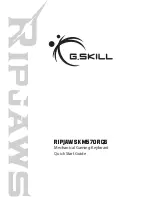
KDFX Reference
KDFX Algorithm Specifications
10-201
In the hard-knee compressor, there is a sudden transition from uncompressed to compressed at the
compression threshold. In the soft-knee compressor there is a more gradual transition from compressed to
unity gain.
Figure 10-105 Hard- and Soft-Knee Compression Characteristics
To determine how much to compress the signal, the compressor must measure the signal level. Since
musical signal levels will change over time, the compression amounts must change as well. You can
control the rate at which compression changes in response to changing signal levels with the attack and
release time controls. With the attack time, you set how fast the compressor responds to increased levels.
At long attack times, the signal may over-shoot the threshold level for some time before it becomes fully
compressed, while at short attack times, the compressor will rapidly clamp down on the level. The release
time controls how long it takes the compressor to respond to a reduction in signal levels. At long release
times, the signal may stay compressed well after the signal falls below threshold. At short release times,
the compressor will open up almost as soon as the signal drops.
For typical compressor behaviorbehavior, the attack time is considerably shorter than the release time. At
very short attack and release times, the compressor is almost able to keep up with the instantaneous signal
levels and the algorithm will behave more like distortion than compression. In addition to the attack and
release times, there is another time parameter: “SmoothTime”. The smoothing parameter will increase
both the attack and release times, although the effect is signi
fi
cant only when its time is longer than the
attack or release time. Generally the smoothing time should be kept at or shorter than the attack time.
You have the choice of using the compressors con
fi
gured as feed-forward or feedback compressors. For
feed-forward, set the FdbkComprs parameter to “Out”; for feedback compression, set it to “In”. The feed-
forward con
fi
guration uses the input signal as the side-chain source. The feedback compressor on the
other hand uses the compressor output as the side-chain source. Feedback compression tends to be more
subtle, but you cannot get an instant attack.
In the feedback con
fi
guration, the signal being compressed may be delayed relative to the side chain
compression processing. The delay allows the signal to start being compressed just before an attack
transient arrives. Since the side chain processing “knows” what the input signal is going to be before the
main signal path does, it can tame down an attack transient by compressing the attack before it actually
happens. In the feed-forward con
fi
guration, the delay affects both the main signal and the side chain, and
In Amp
Out
Amp
Threshold
Out
Amp
In Amp
Threshold
Summary of Contents for K2661
Page 18: ...2 4 LFOs LFO Shapes...
Page 34: ...3 16 DSP Algorithms...
Page 54: ...5 4 MIDI Note Numbers Note Numbers for Percussion Keymaps...
Page 72: ...7 10 System Exclusive Protocol K2661 System Exclusive Implementation...
Page 82: ...9 4 Upgrading Sample Memory Choosing and Installing a SIMM for K2661 Sample Memory...
Page 334: ...10 252 KDFX Reference KDFX Algorithm Specifications...
Page 340: ...11 6 Glossary...
Page 382: ...12 42 Triple Modular Processing Alphanumeric Buttonpad Entries for DSP Functions...
Page 392: ...B 6 SysEx Control of KDFX MSB and LSB...
Page 442: ...D 20 Contemporary ROM Block Objects Controller Assignments Contemporary ROM Block...
Page 490: ...H 12 General MIDI Standard Mode Controller Assignments...
Page 492: ...I 2 Live Mode Objects Live Mode Programs...
Page 498: ...K2661 Musician s Reference Index...
Page 500: ......
















































